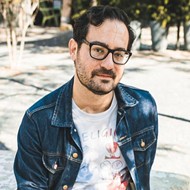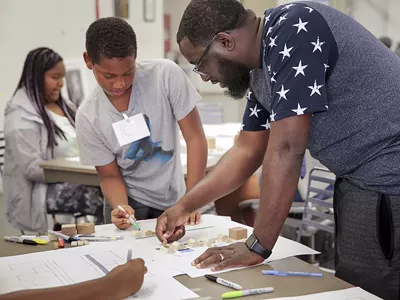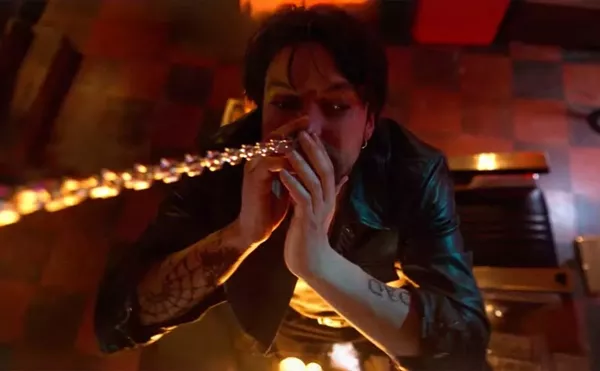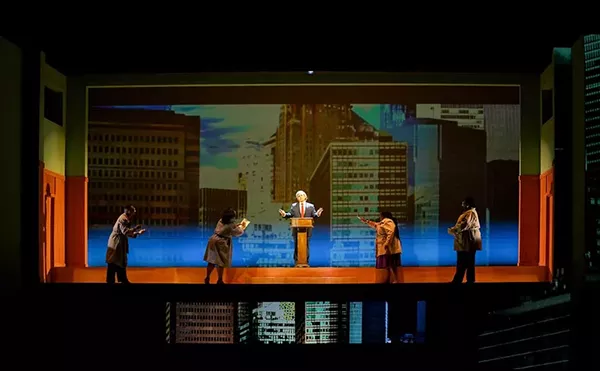

Audio By Carbonatix
[
{
"name": "GPT - Leaderboard - Inline - Content",
"component": "35519556",
"insertPoint": "5th",
"startingPoint": "3",
"requiredCountToDisplay": "3",
"maxInsertions": 100,
"adList": [
{
"adPreset": "LeaderboardInline"
}
]
}
]
Lauren Semivan is a Detroit-based photographer whose work is more than meets the eye. The artist creates intricate, abstract tableaus made from charcoal drawings, found objects, and sometimes even her own body. Door to the Dark, a collection of more than a dozen works, will soon be on display at Detroit's David Klein Gallery.
Metro Times: Can you describe your style?
Lauren Semivan: The work that is in this show has been evolving over the past 10 years. I would say it's the same style — I don't even want to call it a style. That's just what my work looks like!
MT: What is your process like?
Semivan: I work in a studio where I have kind of a stage setting in front of an 8-by-10 camera. I use a large-format 8-by-10 camera from the early 20th century. It uses large sheet film, so every image is made much more slowly because of the nature of how the camera works. I can work on a composition for a few days and then photograph it, make changes, and then photograph it again. That's different than a lot of photographers, who work in a really fast sequence of shooting a lot of images and then looking at everything and being done.
The stage is sort of continually evolving with a new composition. Sometimes it takes up to a week to finish one image. It's kind of more in line with painting, I would say. I'm incorporating drawing and more two-dimensional things and then trying to see how I can get the camera to transform them.
If I use my own body in the image, I don't know what's going to happen with it because I can't see. So there's a lot of chance involved in that. A lot of these are constructed in such a fragile way that they fall apart, or the cat walks by and swats it. [Laughs.] Then it's really hard to start over.
MT: How did you start making images this way?
Semivan: When I was at Cranbrook I had a studio. I painted the whole thing black, just as an experiment. Everyone gets a studio, so I just decided I was going to paint everything black and then use it as the backdrop. I was doing these photographs that were trying to recreate domestic spaces, like with furniture. I decided I had to get rid of everything that goes along with the idea of domestic space in a room. Instead, I just wanted to have more of a spatial experience with the camera. So the black wall was kind of a way to erase all the ideas that go along with a room, or a person alone in a room. I kind of wanted to just work more with the idea of abstracting the space in a way that made it more about perception.
MT: Do you get a lot of responses like this — like, "What am I even looking at?"
Semivan: Yeah. A lot of people just want to know how something is made, and why. I get so into the construction of the images, I have a hard time imagining anything else. I can't take away my experience of making it, so it's interesting to see what people question about them.
MT: Why black and white? Is that because it's an old camera?
Semivan: I can work in color with this camera, and I have. I feel like the images are best suited for black and white because it separates the subject more from reality. If someone sees something and says, "Oh, that's bailing wire, because I can see it's rusty orange," it's less likely to be something people can get lost in than if it's something that can be anything.
MT: Where is your studio?
Semivan: I live in Hamtramck Disneyland. I've been working with Hatch to coordinate the artists residency program there.
MT: That must be a very inspiring place to live, with all the propellers and whirligigs...
Semivan: It's fun. I love to look out the window and see how stray cats interact with the whole thing. There's one that sleeps inside the helicopter and then jumps down. It's like a giant cat toy. It's fun to see how nature interacts with it.
Door Into the Dark has an opening reception from 6-8 p.m. on Saturday, Feb. 3 at the David Klein Gallery, 1520 Washington Blvd., Detroit; 313-818-3416; dkgallery.com; Admission is free. Exhibition runs through March 10.






